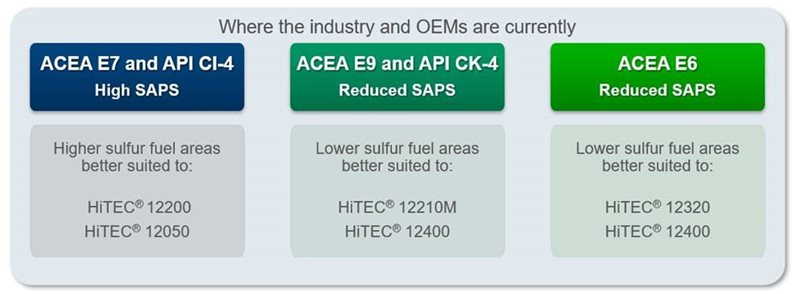What does reduced SAPS engine oil mean for emissions and Total Cost of Ownership?
Aftertreatment systems currently in use include Exhaust Gas Recirculation (EGR), Diesel Oxidation Catalysts (DOC), Diesel Particulate Filters (DPF) and Selective Catalytic Reduction (SCR). These last three systems are sensitive to the level of SAPS in the exhaust stream, which can negatively impact their efficiency.

What causes SAPS in the exhaust stream?
Both diesel fuel and engine oil can contribute to exhaust emissions as, along with the fuel, small amounts of oil will enter the combustion chamber and get burnt.Sulfur is present to varying degrees in diesel fuel depending on the country of sale, although globally levels have reduced over the past two decades. Any sulfur in the fuel will end up in the exhaust, which is why regions and countries with the strictest emissions legislation – and therefore the greatest reliance on aftertreatment technology – mandate the lowest sulfur levels in their fuel. For example, Europe’s current diesel fuel sulfur limit is just 10ppm; down from 500ppm in 1996.
In heavy duty engine oil (HDEO), metallic additives such as detergents and antiwear agents (for example ZDDP), as well as any metallic wear particles from the engine, will create sulfated ash upon combustion. Sulfur and phosphorus are popular as antiwear additives and these elements also increase the level of SAPS.

The SAPS level of finished engine oil depends on both the type and level of components used in the additive package.
Why the move to reduced SAPS engine oils?
High SAPS heavy duty engine oils can block particulate traps/filters, reduce catalyst efficiency and may ultimately result in aftertreatment devices needing to be replaced. Failure of emissions equipment means more vehicle downtime, with extra maintenance and repair costs, and may even attract financial penalties.Tightened limits for CO2, NOx and PM all feature in the latest emissions standards, with NOx and PM reduction being the main target.

Most OEMs now rely on a combination of multiple aftertreatment technologies to meet the standards, so it is essential that all can work unhindered. Reduced SAPS heavy duty engine oils are more compatible with modern aftertreatment systems, and the drive towards reduced SAPS has been reflected in changes in ACEA, API and OEM oil specifications.
Reduced SAPS engine oil development
Reduced SAPS engine oils are only suitable for use in conjunction with lower sulfur diesel fuel. As high sulfur diesel undergoes combustion, it forms a greater level of acidic byproduct, compared to lower sulfur diesel. These acids can be neutralized with the correct amount of detergent additive, which is reflected in the Total Base Number (TBN) of the finished fluid. As moving to a lower sulfur diesel means less acidic products are formed through combustion, the engine oil can be formulated with a lower TBN, hence lower detergent content and overall a lower sulphated ash. However, lowering of the detergent content can impact other performance areas such as piston cleanliness. Therefore, reformulation or rebalancing with other components - which are free of sulphated ash - may be required.So the challenge is to deliver reduced SAPS where necessary for compatibility with aftertreatment systems, but without compromising performance. Striking the right balance requires an understanding of how low the SAPS requirement could go and the ways this could be achieved.
Reducing SAPS may limit the amount of ‘traditional’ (known SAPS-contributing) components that can be used in the finished oil, which raises questions: what alternative chemistries could be used to ensure performance is maintained, and what impact would this have? Synergies and antagonisms between chemistries need to be considered, as well as the potential associated cost.
Choosing the right heavy duty engine oil
Delivering all-round engine protection can be challenging and costly for reduced SAPS oils, yet high SAPS fluids can cause expensive damage to aftertreatment systems. Understanding the market is therefore key for determining the optimum solution.Reduced SAPS engine oils are more suited to markets with low sulfur diesel, as this helps reduce reliance on ash containing components such as detergents and ZDDPs. In regions with higher sulfur diesel, reduced SAPS engine oils may still be an option, although you may not be able to gain the benefit of an extended drain interval. Always follow the OEM’s recommendation.
An optimum engine oil solution will balance the need for emissions legislation compliance against the total cost of ownership (TCO) and will be shaped by the region, the aftertreatment and engine technologies in use (now and in future), as well as typical operating conditions.
Afton has a range of heavy duty engine oil additives that meet all current market needs while keeping abreast of new emissions technologies that may drive future solutions.

For more information, please contact your Afton representative by completing the form below:
Navigate to see Afton Chemical's Heavy Duty solutions and trends transforming the Automotive industry.
HiTEC® 12400: Top Tier Performance for the long haul
